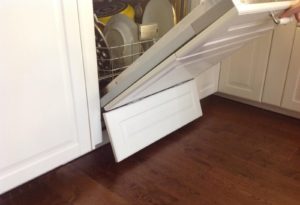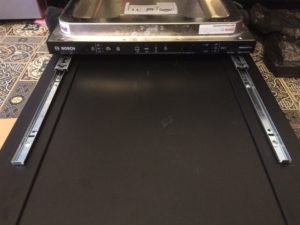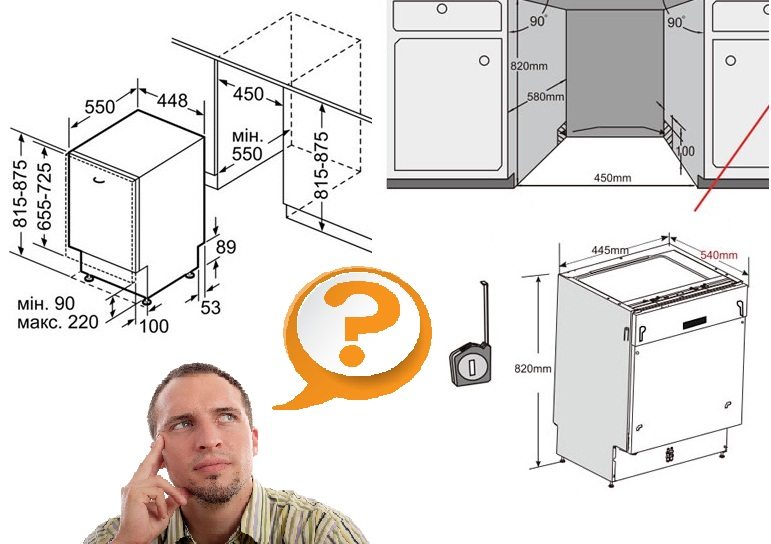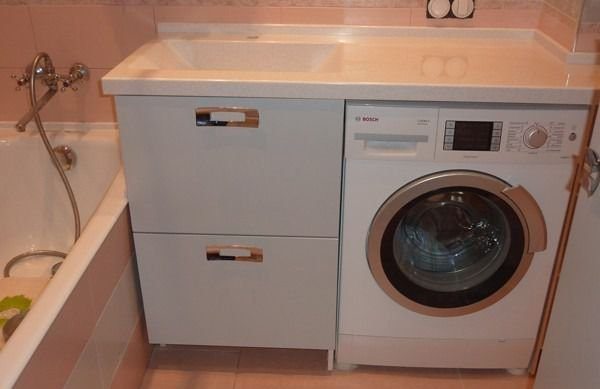How to install a dishwasher in an Ikea kitchen
 Usually, installing a dishwasher in a kitchen, namely its integration, does not create problems. Even a beginning DIYer can do all the work tolerably well in a relatively short period of time. But this is when the kitchen is made taking into account the features of a built-in dishwasher, and what if not? In this article we will look at cases when you need to install a third-party dishwasher in an Ikea kitchen. We will also look at what problems may arise during the work and how they can be solved.
Usually, installing a dishwasher in a kitchen, namely its integration, does not create problems. Even a beginning DIYer can do all the work tolerably well in a relatively short period of time. But this is when the kitchen is made taking into account the features of a built-in dishwasher, and what if not? In this article we will look at cases when you need to install a third-party dishwasher in an Ikea kitchen. We will also look at what problems may arise during the work and how they can be solved.
What is the problem?
In order to install a built-in dishwasher in a niche of kitchen furniture, you need to: connect the water supply hose and drain hose to the machine, insert the body into the niche all the way, and hang the furniture facade. If the kitchen was made to order according to your dimensions, there will be no problems. But if you purchased a ready-made kitchen from Ikea and are trying to integrate a dishwasher into it, say Bosch, Electrolux, Kandy, Smeg, Hansa or another brand, a problem will arise at the stage of hanging the facade.
The fact is that the facade for the dishwasher in a standard IKEA kitchen is higher in height, which is due to the design of the dishwasher. Apparently, it was not for nothing that the manufacturer conceived the design of their dishwasher in such a way that only their equipment could be integrated into their own kitchens without problems, or maybe they simply didn’t think it through. Even if you manage to hang an Ikea facade on the door of a third-party dishwasher, the door simply stops opening, since the lower part of the facade rests against the frame of the niche.
Most often, the Ikea front cannot be hung on the door of a third-party dishwasher at all, due to incompatible fasteners.
Here you have a problem out of the blue. Doors dishwashers from Ikea They have a retractable design that allows you to hang such facades, but other machines cannot boast of this. To adapt such a facade, you will need at least “dancing with tambourines,” but you can do something more cunning. For a fee, furniture makers can remake the facade or make a new one to fit the size of the door. These are additional costs and there is no guarantee that it will be possible to fit the façade precisely. You can try to solve the problem yourself, let's discuss how.
Facade adjustment
Some masters advise using the good old “old-fashioned” fitting method. Its essence is that the facade is simply cut with a jigsaw. You need to saw off the part that prevents the dishwasher door from opening. If necessary, you need to rearrange the fasteners so that the door fits properly. You will have to saw off a piece of about 8 cm, then the facade will “sit” clearly and the dishwasher door will begin to open and close freely. This method has disadvantages.
- Cutting down part of the facade will reveal the lower part of the niche and the legs of the dishwasher. An “unflattering” gap will appear which, in the opinion of many, spoils the furniture composition of the kitchen.
- The facade must be sawed off carefully so that there are no chips along the edges, otherwise it will be hopelessly damaged.
If you manage to make a high-quality cut, you must sand its edges.
- If the facade is not monochromatic and has a pattern or design on the front, this method will not work at all. After all, when we saw off part of the facade, we will disrupt the design, which will 100% ruin the appearance of the furniture.

The first drawback can be eliminated if you do not throw away the neatly sawn-off piece of the facade, but hang it on special Ikea hinges. It will thus dangle freely attached to the bottom of the fitted facade and cover the lower edge of the niche. With this decision we “kill two birds with one stone”: firstly, we preserve the appearance of the kitchen, and secondly, we ensure that the door opens and closes freely. This method is also good because it does not require significant material costs, all you need is your time and patience.
Rising façade
If the front part of the door has a texture or pattern, it definitely cannot be sawed. But what to do then, because even in this form it will not be possible to hang it. There is a solution, although it is not very simple, if you follow the instructions, everything will work out.
- We unscrew the “original” fasteners from the dishwasher door. We leave the fasteners; we will need them.
- We purchase ball telescopic guides for furniture.
- We install one part of the guide on the dishwasher door, and the other on the back of the facade so that they coincide clearly.
- We connect the parts of the guide, while simultaneously hanging the front on the dishwasher door.
Now, when we open the dishwasher door, the facade will move up along the guides and will not interfere with the opening. This design has only one drawback: it will require a lot of space in front of the dishwasher, since when the door is opened, the front will move forward by 30-50 cm, but this is not such a big problem.
So, we are once again convinced that there are practically no unsolvable problems, especially when it comes to integrating a dishwasher into an Ikea kitchen. Be careful and careful, you will certainly succeed.
Interesting:
1 reader comment





















Everything is much simpler!
1. Lower the Bosh machine as far as possible.
2. At the bottom of the machine, unscrew the metal casing with two bolts and throw it away.
And Miracle!!!
We place the door at the level of the other facades and it opens and closes!!!
There is only about 6 centimeters of space between the top of the machine and the table top; you can cover it with a piece of wood if it bothers you.
Tested by me.